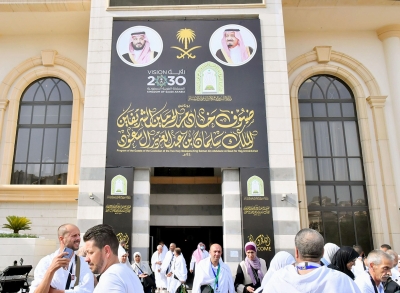
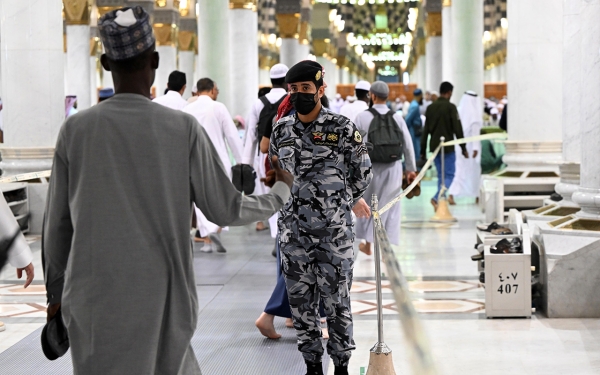
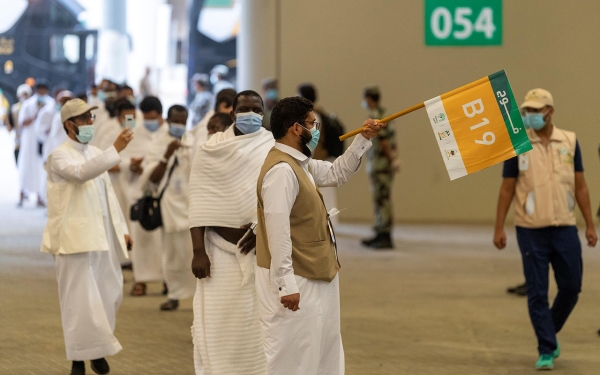
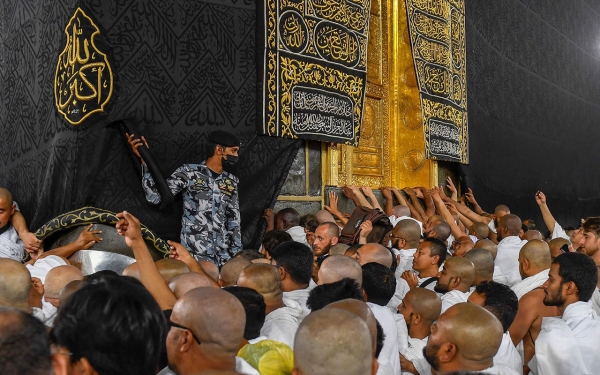
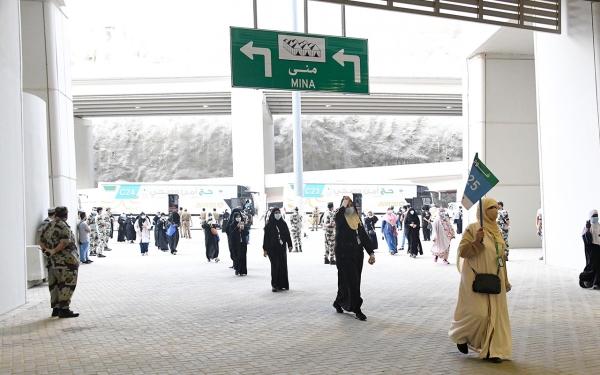
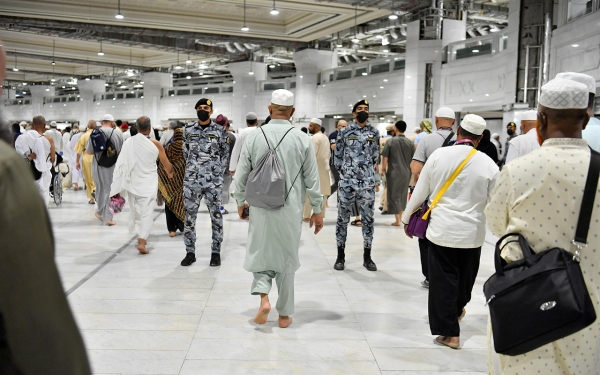
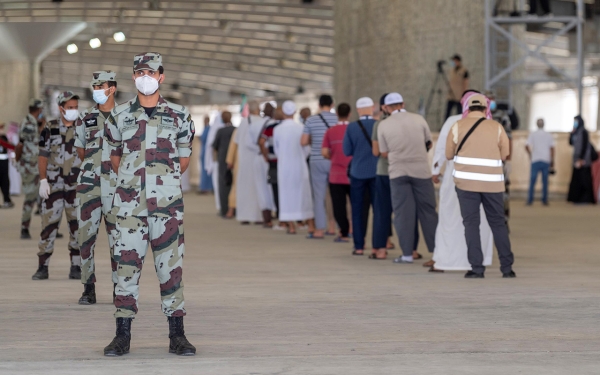
Crowd Management During the Hajj and Umrah Seasons is the system of services, technologies, and plans used by the Kingdom of Saudi Arabia to manage mass gatherings before, during, and after the performance of Hajj and Umrah rituals. This is achieved through coordination between the relevant entities and those organizing the Hajj and Umrah. It also includes the systematic and organized planning and supervision of crowd groups, considering the provision of essential services for pilgrims, Umrah performers, and worshipers, organizing traffic flow, and ensuring their safety.
Crowd management model for Hajj and Umrah seasons
Managing crowds during the Hajj and Umrah seasons has become a global model in crowd management systems and programs, with accumulated experience over years of work, study, and research. Due to the unique circumstances of Hajj and Umrah, the diversity of cultures among the crowds, and their gathering in one place at specific times, the Saudi government has paid attention to assigning tasks to a number of its affiliated or supervised entities. Efforts to organize the seasons and manage human crowds have been distributed among these entities, allowing them to accomplish their tasks and reduce the burdens on workers that would arise if the management process were carried out by a single regulatory body.
Organizing crowd management during Hajj and Umrah seasons
The Hajj and Umrah seasons are among the largest organized crowds managed worldwide, with several entities collaborating to manage them and provide studies, including:
The Ministry of Hajj and Umrah
The ministry employs electronic applications to serve pilgrims and Umrah performers, contributing to their development. It also establishes monitoring and surveillance systems, develops spatial databases, and works on electronic collaboration with the Transport Information Center. Additionally, it develops transport contracting mechanisms to enhance transport services.
The Institute of the Custodian of the Two Holy Mosques for Hajj and Umrah Research
The institute was established in 1975. It studies everything related to crisis and crowd management during Hajj, develops and enhances scientific research fields, and formulates concepts, proposals, plans, and solutions related to managing Hajj affairs and holy sites using crisis management methods. This has contributed to the development of crowd management during Hajj seasons.
The Global Center for Mass Gatherings Medicine at the Ministry of Health
It supports the adoption of practices to improve services provided to crowds, and the use of modern techniques in the field of crowd health and management by enhancing research and scientific studies, developing the human resources working in the field, activating the role of the community in promoting health during gatherings, establishing a health information system for crowd management, and building local and international relationships for exchanging experiences and cooperating with international organizations and specialized centers in crowd health and management to benefit from them during the Hajj season.
General Authority for the Affairs of the Grand Mosque and the Prophet's Mosque
The authority, represented by the General Administration of Crowds and Guidance, provides efforts throughout the day in cooperation with several entities to facilitate the entry of pilgrims and Umrah performers to the Grand Mosque. Observers perform their roles throughout the day, taking turns along the pathways, to organize movement, prevent crowding, and ensure the smooth and uninterrupted flow of traffic.
The Special Forces for Hajj and Umrah Security
The Special Forces of Hajj and Umrah Security work to maintain security, monitor organizational and guidance activities, and manage crowd movement during the Hajj and Umrah seasons, in addition to serving pilgrims and Umrah performers, preserving security, and providing humanitarian and awareness services around the clock as part of a plan implemented by qualified human resources, technological devices, and digital surveillance cameras managed from the operations room of the forces, to achieve the security and comfort of pilgrims and Umrah performers during their presence in Makkah al-Mukarramah or the holy sites.
General Directorate of Civil Defense
The General Directorate of Civil Defense develops plans aimed at taking appropriate measures to protect pilgrims and citizens, providing safety from accidents and disasters, and protecting public and private property, by following administrative procedures in coordination with relevant authorities, and implementing measures to address any emergencies that may occur during all Hajj rituals.
Additionally, the General Directorate of Civil Defense benefits from modern information technologies in its civil defense operations, including the Geographic Information System (GIS), which builds spatial geographic databases and links them to informational data for a number of key landmarks, vital facilities, and populations. This system is applied in civil defense operations in several areas and enjoys great flexibility, allowing civil defense leadership to develop the necessary policy for the system, implement it on the ground, and ensure its compatibility with a number of other programs and systems.
Pilgrim Experience Program
One of the programs of Saudi Vision 2030, it revolves around three pillars, one of which is providing high-quality services to pilgrims and Umrah performers. Elevating crowd management is a criterion for achieving this pillar, along with monitoring the improvement of services and reducing waiting times, all of which contribute to facilitating the journey of pilgrims and Umrah performers.
As for the organized transportation services for the flow of pilgrims and Umrah performers, the Kingdom prepares everything necessary to facilitate the process smoothly, starting from the airports of the countries they are coming from to Makkah al-Mukarramah, whether for Hajj or Umrah, through receiving them at Saudi airports, until their return to their countries.
Saudi Arabia Railways 'SAR'
Through the Haramain High Speed Railway project, services are provided for transporting pilgrims between Makkah al-Mukarramah and al-Madinah al-Munawwarah. The project has recorded a punctuality rate of up to 98 percent. Additionally, al-Mashaaer al-Mugaddassah Metro line, which has a capacity of 72,000 passengers per hour, operates double trips accommodating about eight hundred passengers and transports three thousand pilgrims every ninety seconds.
Saudi Public Transport Company "SAPTCO"
In cooperation with several companies, it contributes to providing transportation services and buses during the Hajj season. Travel companies, within their scope, monitor Hajj activities, organize the movement of pilgrims, and facilitate their dispatching by developing plans and hypotheses for managing crowds in the holy sites.
Crowd management during the Hajj and Umrah seasons using artificial intelligence
The Ministry of Interior, represented by the General Directorate of Public Security, in cooperation with the Saudi Data and Artificial Intelligence Authority 'SDAIA', used artificial intelligence algorithms for the first time in the Hajj season of 2023, through the Sawaher and Baseer platforms, to enhance the accuracy in monitoring security phenomena in the Grand Mosque and the holy sites, develop proactive security plans to manage and organize crowd movement, and pass this data to decision-makers in the operations and control center for decision-making.
Managing crowds during peak times
Peak times throughout the year require a multiplied readiness to manage crowds. The General Administration of Crowds and Guidance, affiliated with the General Presidency for the Affairs of the Grand Mosque and the Prophet's Mosque, provides organized efforts around the clock, characterized by flexibility and integration with specialized entities, to facilitate the guidance process and manage crowds.
The Friday prayer morning is considered one of the busiest times during the week. In terms of months, Ramadan represents the most densely populated month numerically, along with the Hajj season, which includes millions of people moving from one place to another at specific times according to well-thought-out plans.
The entities involved in guiding pilgrims enhance their readiness during peak times and coordinate among themselves to manage crowds. They train their human resources to professionally handle crowds, facilitating the arrival of visitors to the Grand Mosque's courtyards and prayer areas, as well as their movement between floors.
The relevant entities develop various plans according to the current situation. For example, pilgrims are directed to the first and second floors when there is a high concentration of people on the ground floor of the Mas'a. Additionally, guidance exits are closed when the numbers increase and reopened at the appropriate time.
The staff of the Crowds and Guidance Management at the Grand Mosque oversee movement in the area of the Tawaf and the pathways leading to it, as well as the courtyards and expansions. They analyze and classify data, find suitable solutions, and coordinate with security agencies and the authority to address any observations. Additionally, the management prepares alternative plans to be implemented in case of any issues during the dispatching process.
Related quizzes
